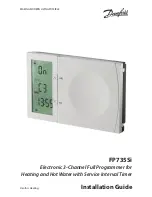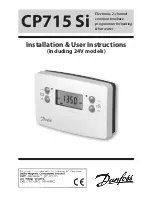
CHAPTER 10: THEORY OF OPERATION
OVERVIEW
L90 LINE CURRENT DIFFERENTIAL SYSTEM – INSTRUCTION MANUAL
10-3
10
samples by minimizing the sum of the squares of the errors gives rise to the first frequency component of the Discrete
Fourier Transform (DFT). In the case of a data window that is a multiple of a half cycle, the computation is simply sine and
cosine weighted sums of the data samples. In the case of a window that is not a multiple of a half-cycle, there is an
additional correction that results from the sine and cosine functions not being orthogonal over such a window. However,
the computation can be expressed as a two-by-two matrix multiplication of the sine and cosine weighted sums.
Phaselets and sum of squares are computed for each phase at each terminal as follows. For the real part, we have:
Eq. 10-1
For the imaginary part, we have:
Eq. 10-2
where
k is the present phaselet index
N is the number of samples per cycle
p is the present sample index
The computation of phaselets and sum of squares is basically a consolidation process. The phaselet sums are converted
into stationary phasors by multiplying by a precomputed matrix. Phaselets and partial sums of squares are computed and
time-stamped at each relay and communicated to the remote relay terminals, where they are added and the matrix
multiplication is performed. Since the sampling clocks are synchronized, the time stamp is simply a sequence number.
10.1.5 Disturbance detection
A disturbance detection algorithm is used to enhance security and to improve transient response. Conditions to detect a
disturbance include the magnitude of zero-sequence current, the magnitude of negative-sequence current, and changes
in positive, negative, or zero-sequence current. Normally, differential protection is performed using a full-cycle Fourier
transform. Continuous use of a full-cycle Fourier means that some pre-fault data is also used for computation. This can
lead to a slowdown in the operation of the differential function. To improve operating time, the window is resized to the
half-cycle Fourier once a disturbance is detected, thus removing pre-fault data.
10.1.6 Fault detection
Normally, the sum of the current phasors from all terminals is zero for each phase at every terminal. A fault is detected for
a phase when the sum of the current phasors from each terminal for that phase falls outside of a dynamic elliptical
restraint boundary for that phase. The severity of the fault is computed as follows for each phase.
The differential current is calculated as a sum of local and remote currents. The real part is expressed as:
Eq. 10-3
The imaginary part is expressed as:
Eq. 10-4
The differential current is squared for the severity equation:
Eq. 10-5
The restraint current is composed from two distinctive terms: traditional and adaptive. Each relay calculates local portion
of the traditional and restraint current to be used locally and sent to remote peers for use with differential calculations. If
more than one CT is connected to the relay (breaker-and-the half applications), then a maximum of all (up to four) currents
is chosen to be processed for traditional restraint.
















































